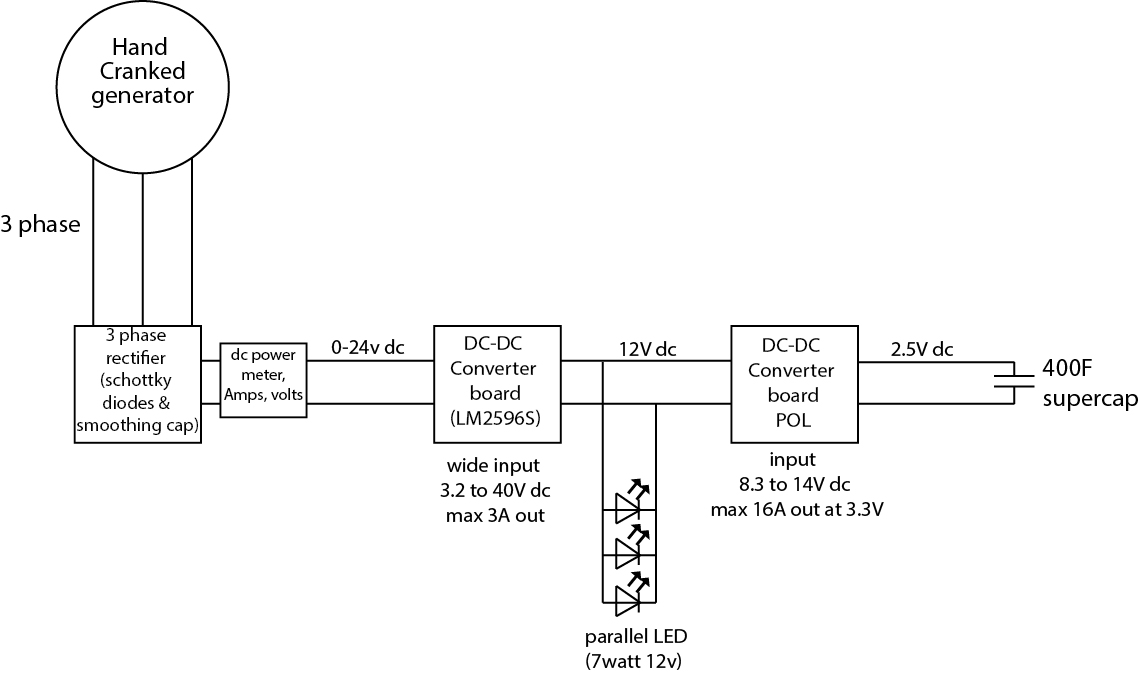Hello,
A newbie with a question here, please be gentle.
I am tryng to understand why I get such different power outputs when I swap between an array of LED's at 12V, vs no LED array connected, but charging a supercap at 2.5v DC.
The rough circuit is below.
I am using a hub motor (250watt, 24v) as a hand crank generator. The hub motor has internal planetary gearing so it's spinning about 300 rpm.
I rectify the three phase output and I can see with an inline power meter that I get between 0 and 24v depending how vigorous I am feeling. The smooth-ish DC goes to a step down converter board which gives me 12v, which I can see with another meter (not shown in pic).
When I connect only a 14watt 12v array of LED's I can get amazing output, in fact I can easily output 20 to 30 watts, way too much for the array, and about the limit that little DC converter (it maxes out at 3A)
If I then disconnect the LED's and use another DC -DC point of load converter to drop the 12v to a stable 2.5 volts out ( which I see with another meter - not shown in pic) then the generator spins freely and I am only able to output about 6 watts. It varies a little depending on how charged the supercap is, but I thought the supercap acts like a dead short when empty (so I manualy add a few ohm resistor, then remove it at around .5v) and up to about 13watts when I have about 1.3v in the cap.
Q1: For my understanding. What do you think is the reason for that? Why would the supercap not appear as an equivalent load?
Q2: Advice: I want to charge the cap as quickly as possible using my vigour while it lasts.. Is there a better way to dump all this power into a single 2.7v cap?
Many thanks

A newbie with a question here, please be gentle.
I am tryng to understand why I get such different power outputs when I swap between an array of LED's at 12V, vs no LED array connected, but charging a supercap at 2.5v DC.
The rough circuit is below.
I am using a hub motor (250watt, 24v) as a hand crank generator. The hub motor has internal planetary gearing so it's spinning about 300 rpm.
I rectify the three phase output and I can see with an inline power meter that I get between 0 and 24v depending how vigorous I am feeling. The smooth-ish DC goes to a step down converter board which gives me 12v, which I can see with another meter (not shown in pic).
When I connect only a 14watt 12v array of LED's I can get amazing output, in fact I can easily output 20 to 30 watts, way too much for the array, and about the limit that little DC converter (it maxes out at 3A)
If I then disconnect the LED's and use another DC -DC point of load converter to drop the 12v to a stable 2.5 volts out ( which I see with another meter - not shown in pic) then the generator spins freely and I am only able to output about 6 watts. It varies a little depending on how charged the supercap is, but I thought the supercap acts like a dead short when empty (so I manualy add a few ohm resistor, then remove it at around .5v) and up to about 13watts when I have about 1.3v in the cap.
Q1: For my understanding. What do you think is the reason for that? Why would the supercap not appear as an equivalent load?
Q2: Advice: I want to charge the cap as quickly as possible using my vigour while it lasts.. Is there a better way to dump all this power into a single 2.7v cap?
Many thanks

